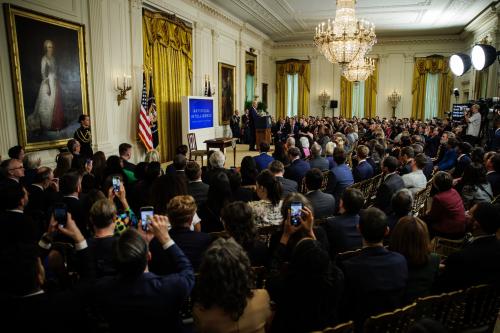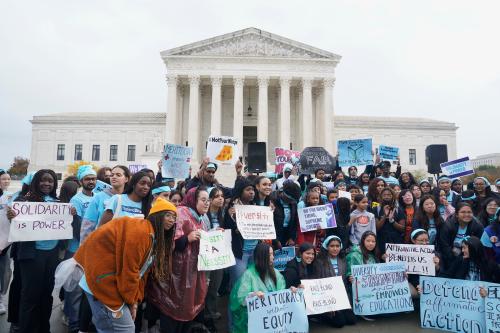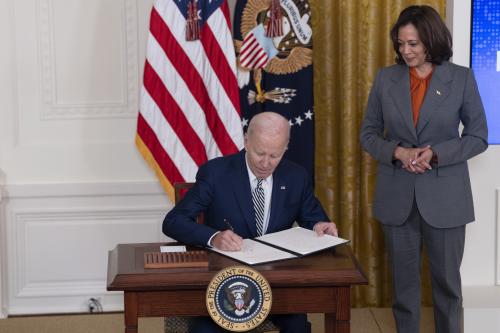Artificial intelligence is advancing rapidly. It is powering autonomous vehicles and being applied in areas from health care and finance to retail sales and national defense. As noted in a 2018 Brookings Institution report, “AI is a technology that is transforming every walk of life. It is a wide-ranging tool that enables people to rethink how we integrate information, analyze data, and use the resulting insights to improve decisionmaking.”
Yet most of the current AI impetus in the United States comes from the private sector. America has many of the most innovative technology firms in the world and our talent pool is quite strong. Our system of higher education is the envy of the world and thousands of foreign students come to the United States every year to learn science, math, and engineering.
But those achievements should not lull Americans into a false sense of complacency, or a false sense of security. There is considerable concern the U.S. federal government is not doing enough to support AI research and deployment. As an illustration, OpenAI co-founder Greg Brokerman has testified before Congress that our national government invests only $1.1 billion in non-classified AI technology. That is far lower than the $150 billion being committed by China over the next decade. It also is worth noting that in addition to this Chinese investment and as a result of the 19th Party Congress, President Xi Jinping has called for China to surpass the U.S. technologically by 2030. That kind of strategic vision, continuity of leadership, and nearly unlimited resources do not augur well for us.
These are not just idle promises on the part of the Chinese. Scientists in that country have made remarkable progress over the past decade in AI research. According to a 2018 Tsinghua University report, “China leads the world in AI papers and highly cited AI papers.” It also has “more AI patents than [the] U.S. and Japan.” The traditional interpretation that China lags American ingenuity needs to be updated in light of recent scientific advances.
To address these concerns, President Donald Trump yesterday announced a new executive order for a national strategy called the “American AI Initiative.” Michael Kratsios, the deputy assistant to the president for technology policy at the White House, has explained that America needs a national AI strategy. In a Wired op-ed, he argues “under the American AI Initiative, federal agencies will increase access to their resources to drive AI research by identifying high-priority federal data and models, improving public access to and the quality of federal AI data, and allocating high-performance and cloud computing resources to AI-related applications and R&D.”
The initiative outlines several welcome steps. It seeks to increase access to federal data, provide financial support for R&D, enhance digital infrastructures, and improve workforce development. Those are all noble goals where the United States needs to do better. For example, having better access to government data would strengthen the training of AI algorithms and help software overcome the inherent biases of incomplete or misleading information.
And having faster broadband, more ubiquitous mobile networks, and faster computers is vital for AI deployment. New advances in autonomous vehicles, remote surgery, streaming videos, and national security require improvements in computing capacity. It will be impossible to take advantage of the full capabilities of AI without this type of progress.
A related competition also is taking place in regard to 5G networks. As noted recently by Brookings Fellow Nicol Turner-Lee, this is the high-speed mobile communications technology that will enable enhanced communications and advanced technology solutions. China has invested billions there and this is just one more manifestation of the technology competition that the U.S. needs to take seriously.
What is unclear in the president’s new initiative, however, is how much AI funding is being provided and how it is being implemented. Sometimes, new announcements such as the one formed to combat the opioid crisis have been introduced with great fanfare, but shown little impact. Without additional funding for research, workforce development, and infrastructure, the new initiative likely will fall flat.
On the implementation front, there also are question marks regarding the executive order. It is one thing to call for inter-agency cooperation and coordination, and another to develop effective mechanisms that do that. Agencies need to coordinate, but they have incentives to pursue their own vision, not that of the White House or Office of Management and Budget.
One promising sign is the U.S. Department of Defense already has announced its implementation plan. In a press release put out this week and reported in the news, it said, “The impact of artificial intelligence will extend across the entire department, spanning from operations and training to recruiting and health care. The speed and agility with which we will deliver AI capabilities to the warfighter has the potential to change the character of warfare. We must accelerate the adoption of AI-enabled capabilities to strengthen our military, improve effectiveness and efficiency, and enhance the security of our nation.”
But the DoD is far ahead of many of the U.S. domestic departments. It has set up a new AI Center, hired AI experts, and set aside money for AI deployment. Along with similar actions from federal intelligence-gathering agencies, these steps go beyond what has happened in the non-defense part of government. In those places, there has been little action, limited funds targeted on bringing AI into the government, and few people employed with AI skills.
Moving forward, it will be important to bring the domestic agencies into the AI era. In the private sector, AI is improving efficiency, boosting productivity, and bringing creative digital solutions into organizations. We need to do the same thing across all of government so the public sector can show the same type of progress seen outside of government.
Making progress on vision, funding, and infrastructure is important for national competitiveness and national security.
Making progress on vision, funding, and infrastructure is important for national competitiveness and national security. Adversaries are deploying autonomous weapons systems, AI-based intelligence-gathering and assessment, and remote imagery based on satellite and drone data. Having systems that are faster, smarter, and more coordinated is necessary in order to protect the country. Until we see the details for the comprehensive implementation of the national AI initiative, it will be hard to assess the long-term impact and effectiveness of the president’s AI executive order and whether it can redress the lengthening gap between the U.S. and China on AI, 5G, and other emerging technologies.









Commentary
Assessing Trump’s artificial intelligence executive order
February 12, 2019